| Photojournal
- 7 October 2006
Say
hi to Herman
|
On the 7th of October,
I got up earlier than a human should ever have to get up. I had
spent the night in a motel in Hope, and I had a shower and had
all my gear in the car by 7:00. That's 7:00 a.m. I dropped off
my keys and went in search of a Tim Horton's for breakfast.
I found no Tim's, and
ended up settling for a coffee and a muffin from a service station
across the street from my motel. After finishing the muffin, I
drove back to the Hope Slide, arriving a little before 7:30. It
was turning light at this point, but because the slide is in a
deep narrow valley, the really nice sunrise light wasn't getting
anywhere near where I was.
I got out of the car,
thankful that I had thought to bring a sweatshirt, winter jacket,
hood, and gloves, because it was pretty nippy out. I went over
to the picnic table near where I'd seen the pika the day before,
and found neither pika nor chipmunk. The only familiar face around
was that of a Stellar's Jay.
|
|
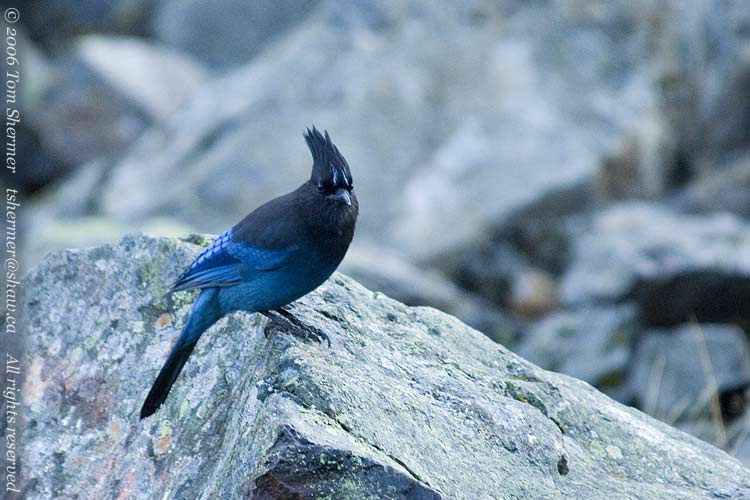 |
| I looked
for little mammals for about ten minutes, and found that from the
top of one rock I had climbed on, I could see over some trees to
the valley to the east. The sun was shining there, and there was
some fog along the valley bottom that was lit up in places. |
|
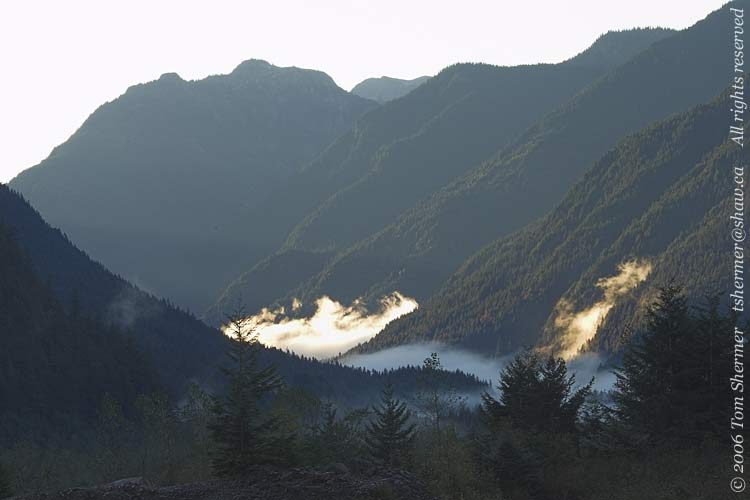 |
|
I spent another twenty
minutes or so waiting and looking for pikas or chipmunks, with
no luck. Even with my warm clothing, I was getting farily cold
by this point, and so I sat back in my car and ran the heater
while I changed the lens on my camera from my telephoto to my
wideangle. If critters weren't showing up, I'd start using my
time to take landscapes.
Once I was back out,
I took a photo of the mountain where the slide took place. Because
of the wideangle, this photo gets in more of the mountain than
my photos of the day before.
|
|
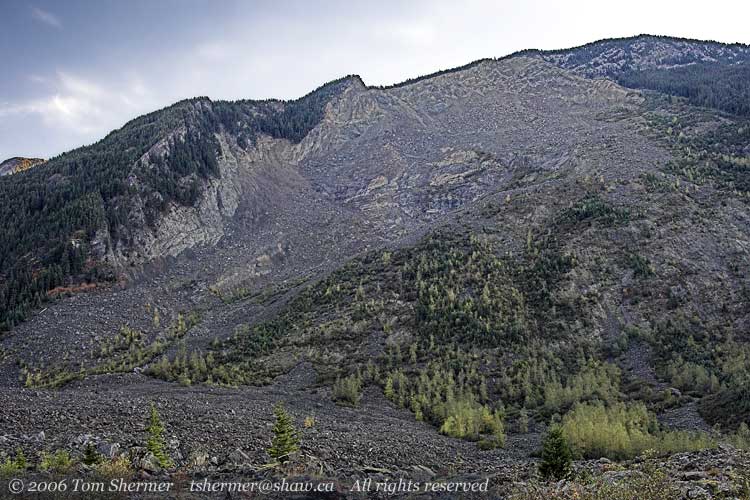 |
| Facing back
the other way, I caught the rest area parking lot and the morning
light hitting the mountains on the other side of the valley. These
mountains were quite near me, as the valley was quite a narrow one. |
|
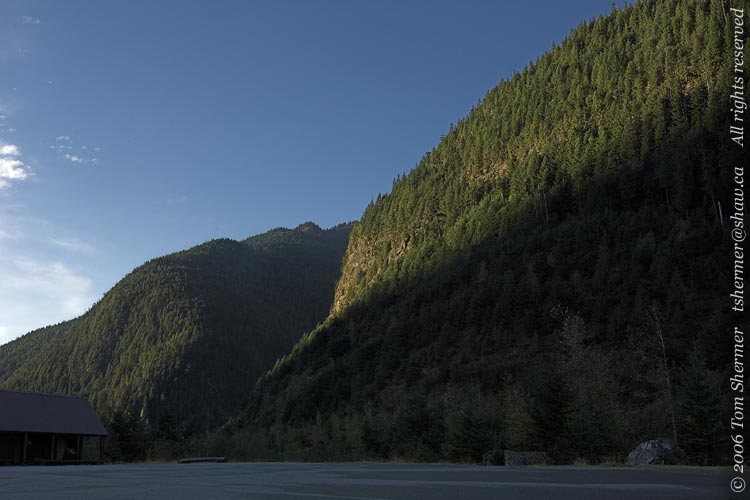 |
|
It really was pretty
cold out, and the sun was taking its time getting high enough
to peek over the mountains and light up (and warm up) the area
I was in. After taking a number of landscapes, I warmed myself
in the car again and switched back to my long lens. I then spent
more time scouting around for the critters.
With each passing minute,
I was getting colder and colder, but gaining more and more appreciation
for pikas. Any animal that doesn't get up as early as I did that
morning has my respect and admiration. It was a perfect morning
to stay curled up in bed, instead of being out clambering around
on cold talus. These pikas were sure behaving a lot more sensibly
than I was.
I had gained a deep
appreciation of chipmunk habits the day before, and now of pika
habits, so this seemed to be turning into a trip where I was really
learning to respect nature.
Well, eventually, around
9:15, the sun hit the talus field and things started to warm up
a bit. Then a pair of pikas popped up, so I grabbed my tripod
and headed over near where they were. The first one I got photos
of was munching on some grass.
|
|
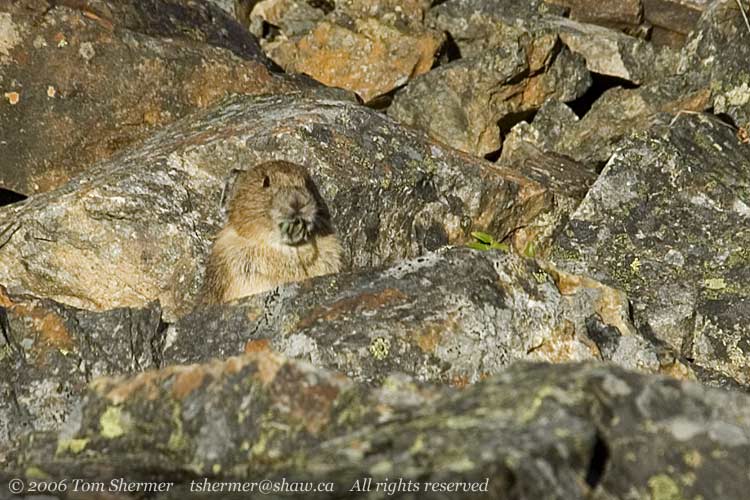 |
| And the
other one had disappeared and then reappeared a little bit farther
away from me. He struck a posture where he seemed quite bloated
and much more egg-shaped than your usual bunny. |
|
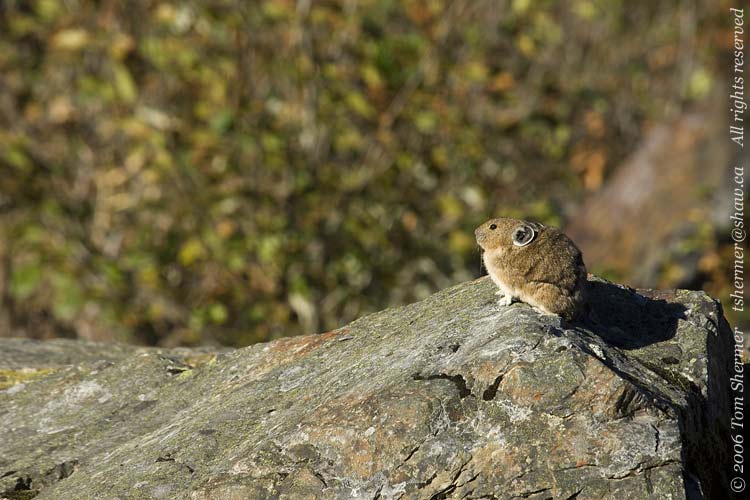 |
| The first
one had noticed me, and was standing alert, looking my way. |
|
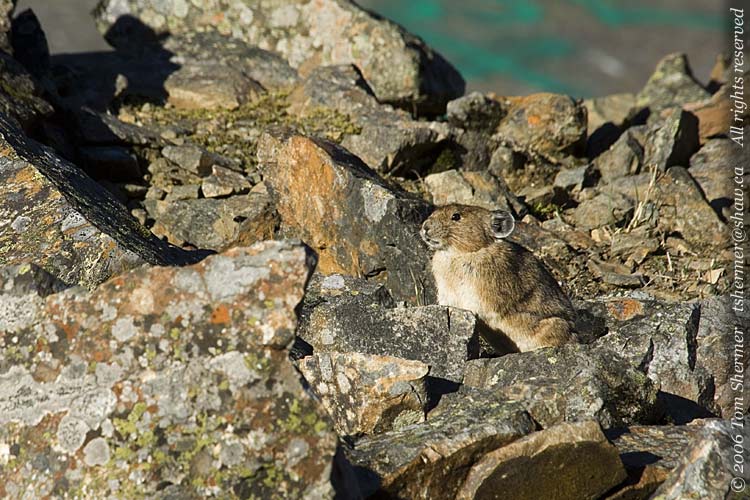 |
| Then he
did an odd thing...he hopped through the rock towards me,
and then up onto a rock where he could really check me out. I got
a few photos of him when he did. |
|
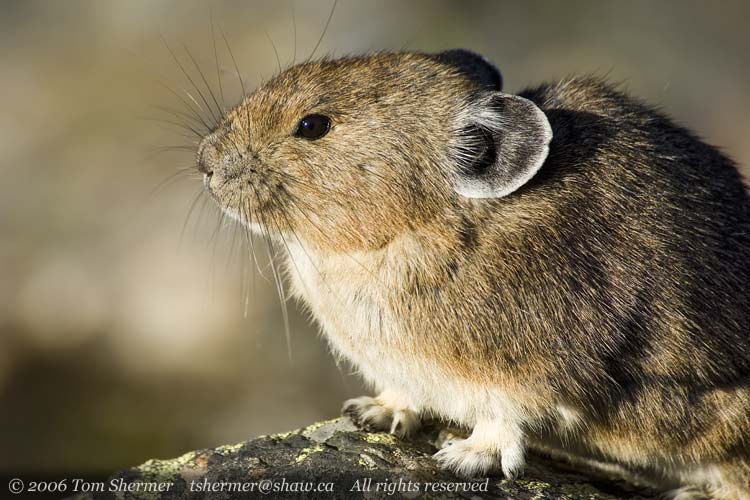 |
|
He was only there for
a few seconds. He then hopped away behind some rocks, his curiousity
satisfied. His friend had disappeared as well.
Having now gotten some
sunlit pika photos, I looked around at the talus and decided that
some rock photos were in order. The colors, patterns, and textures
were really neat, and I hadn't gotten any photos the day before
that did them justice.
So I put my general
lens on and started taking rock photos. On this one, I liked the
interplay of green, grey, and white, with the occasional spots
of rusty orange.
|
|
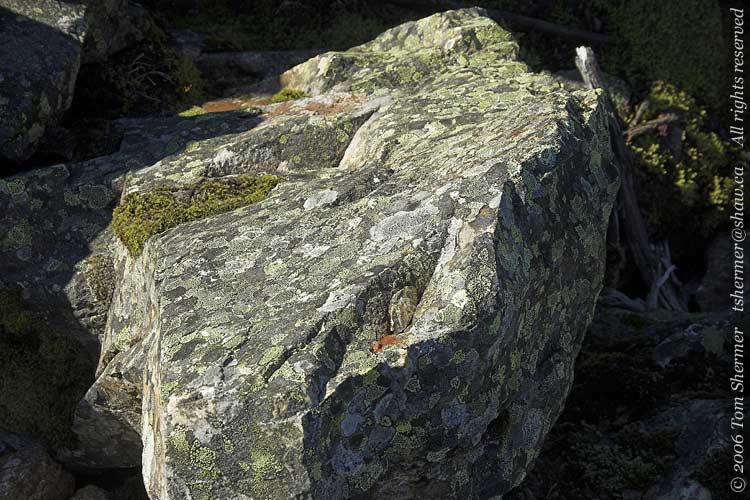 |
| That seemed
to be a common surface motif for some of the rocks, and next I went
for a photo just trying to capture the pattern. |
|
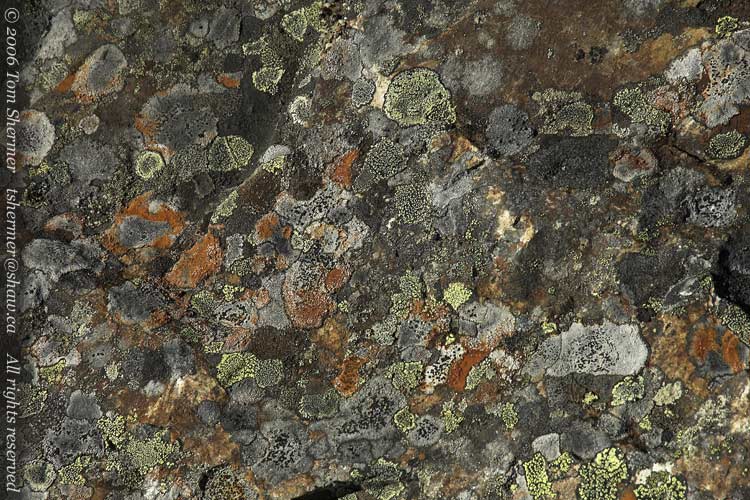 |
| That was
not the only color pattern, by far. Here's another one, with reds,
oranges, pinks, blues, and purples. |
|
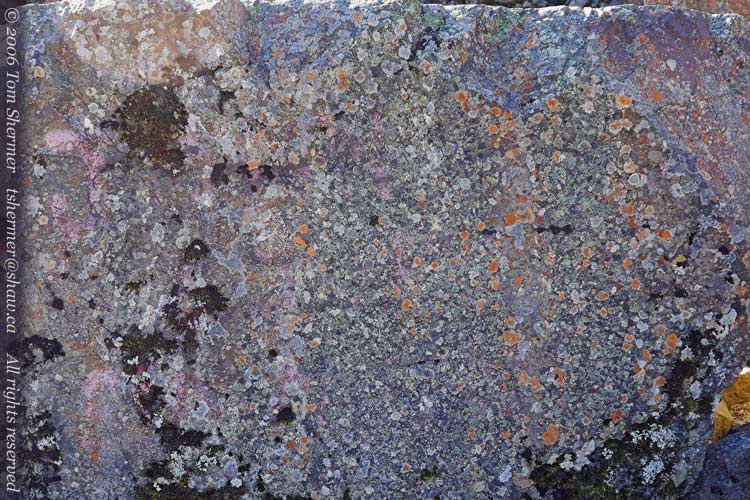 |
|
As I was looking at
all of these rocks, with their different colors, and textures
and such, I found myself wishing that my friend Carlo was with
me. Carlo's a geologist and would have been able to explain all
of the neat stuff I was seeing. Maybe one day I'll drag him out
there with me.
Here's some rock where
the texture, rather than the color, caught my eye. Of course,
the color adds to my interest in it, though.
|
|
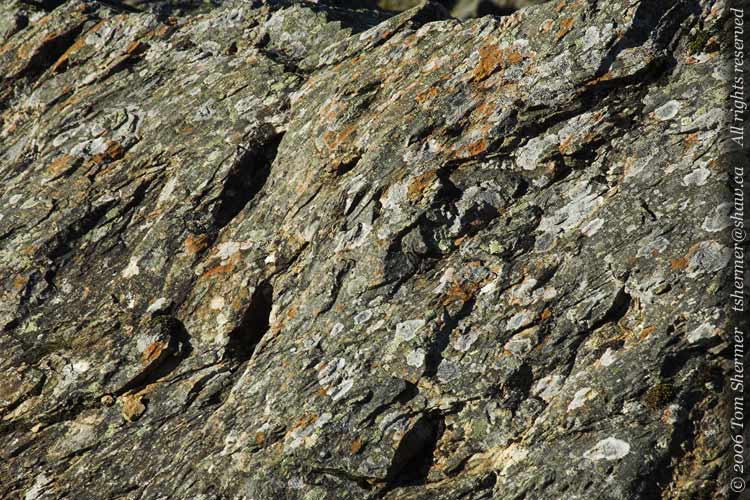 |
| And here's
one where the bright sun makes the rock all about texture and form,
and not about color at all. |
|
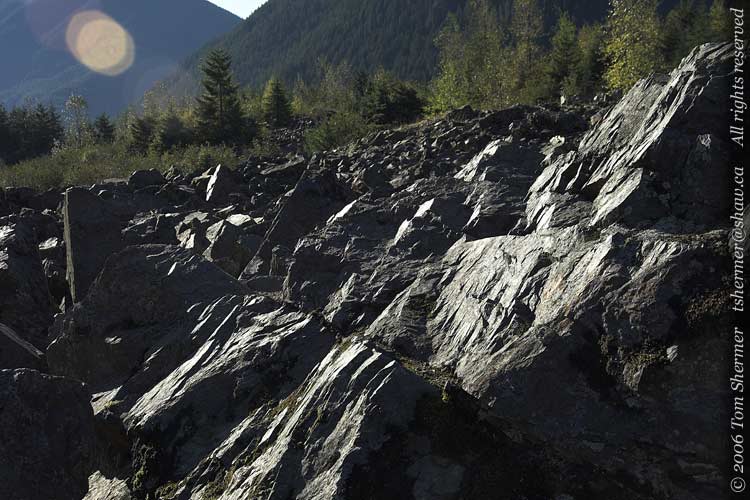 |
|
I like the way that
all of the color in that photo ended up in the top portion, and
I thought that the lens flare (those yellow/orange circles formed
by the sun hitting the lens) added to it, as well.
I had a great time
taking rock photos, but after a while doing that, I was ready
for more wildlife. So I put the long lens back on the camera and
started wandering. I had some birdseed in my pocket, which I had
placed there earlier in hopes of using it to try to draw the Stellar's
Jays near me for some close-ups. Around 10:00 I started spreading
some of it on the rocks.
Well, a Yellow-pine
Chipmunk must've seen what I was doing, because he came scurrying
over towards me. As he did, I got a few photos. I like the way
that these guys can hold their tails straight out, so I was happy
to get a photo showing that.
|
|
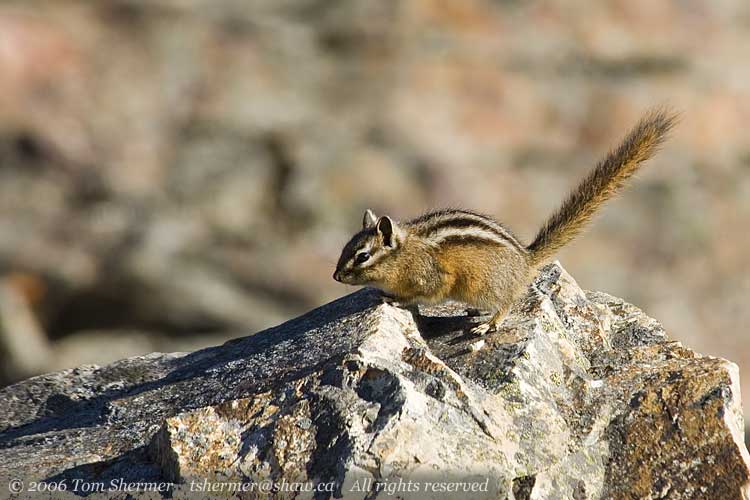 |
| As he got
near, I took my camera off my tripod and squatted down to take photos.
At one point, he stopped to do a little grooming. |
|
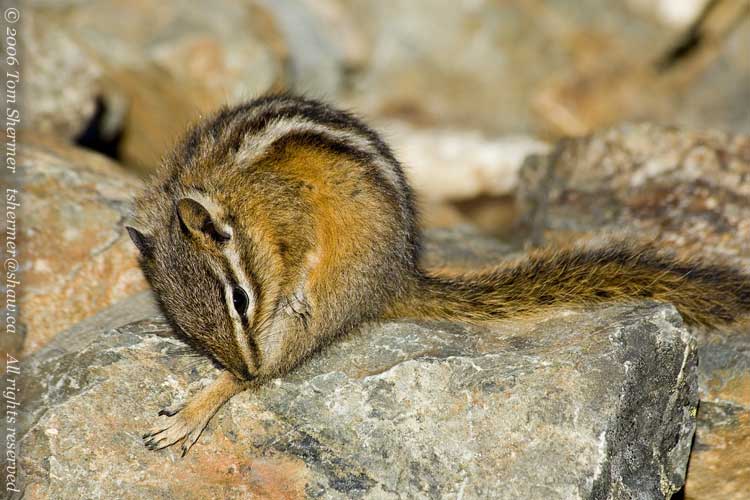 |
| But then
he jumped up onto the rock that I had spread the birdseed on, and
started sniffing around and collecting the seed. |
|
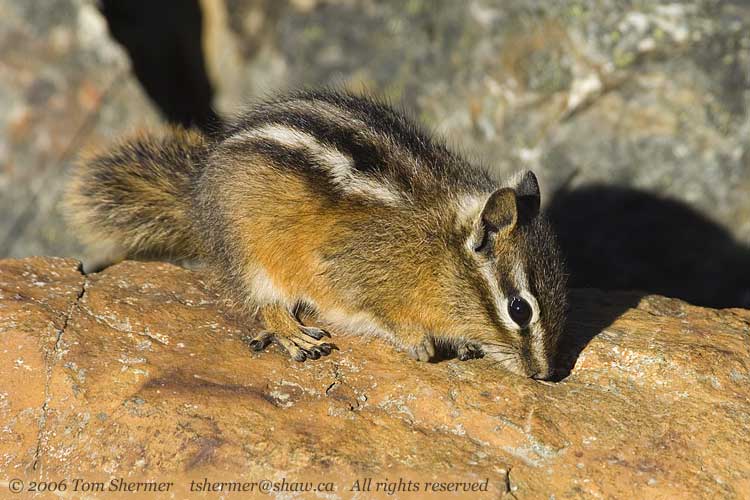 |
| I moved
a little farther away, so that I was sure the chipmunk would be
far away enough for me to focus on. (My long lens won't focus on
anything two meters away or closer.) Then I laid down on the rock
so that I could look through the viewfinder while the camera was
resting on the rock. This let me get low-angle and eye-level shots
of the little guy as he went from rock to rock doing chipmunk stuff. |
|
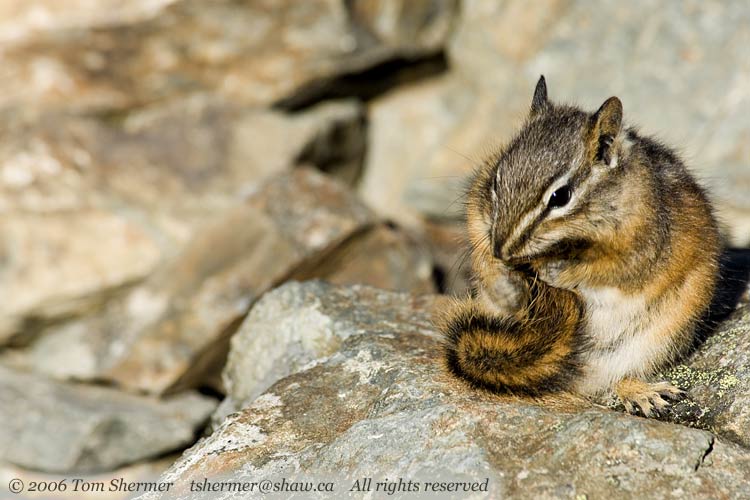 |
| Here's one
from after he had sucked up a lot of birdseed. I guess you know
you're carrying a lot when you can't tell where your cheeks end
and your shoulder begins. |
|
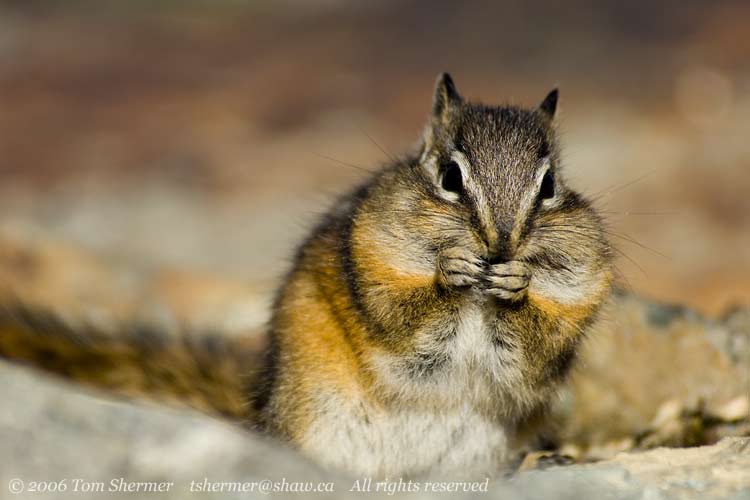 |
|
It was now about ten
minutes after ten o'clock, and my camera stopped taking photos
because I had filled up the memory card. It's a 4-gigabyte card,
and normally that'll do for a whole day's shooting for me, and
here it was still mid-morning and the card was full. I got out
another one (I always carry a fair amount of spare memory) while
thinking that I should maybe be careful with the pace of my photos.
But when the subjects present themselves, it's hard not to shoot.
And as I was putting
the spare card in, another subject did present himself, bounding
over the rock to say hi. Readers, I'd like for you to say hi to
my new friend Herman.
|
|
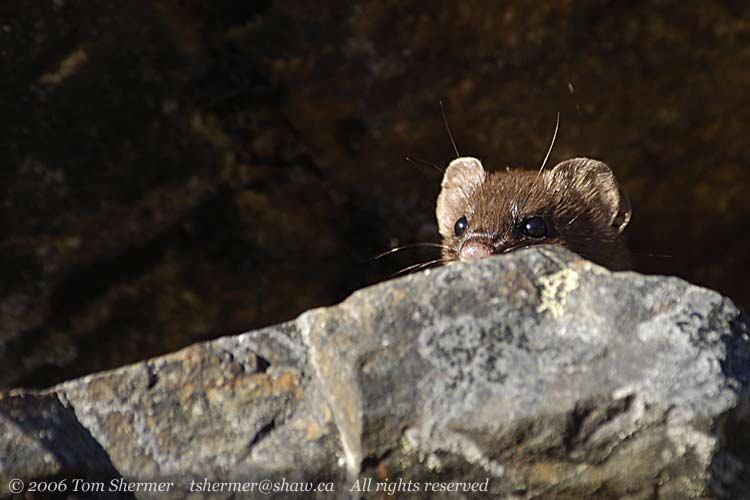 |
|
Now, I didn't call
this guy Herman because I thought that he was vermin; first, I
don't consider him vermin, and second, I would never stoop
to giving things rhyming names like that. I called him Herman
because he is what my friends from Germany would call a Hermelin.
Despite his initial
approach, Herman didn't seem to be too camera-shy, and soon showed
me his full body...although I must admit that he was sort of twisting
and turning a bit rather than holding still for my portrait.
|
|
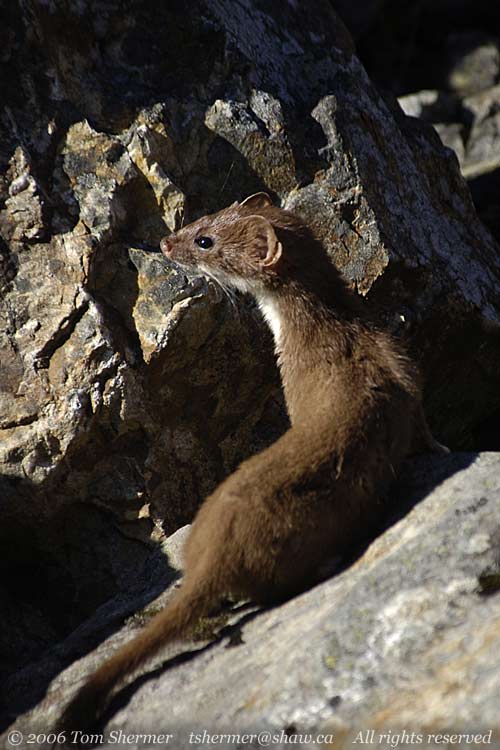 |
|
Maybe all that wasn't
too clear, so perhaps I should summarize: the squirmin' Hermelin
Herman is no vermin; I've determined that Hermelin is German
for Ermine.
That's right, my new
friend Herman is an Ermine. You might associate Ermines with pure
white fur, but that's their winter pelage. In the summer, they're
brown on top and white below. According to my books, it's actually
a little late for Herman to still be in his full summer colors...many
Ermines are in transitional color by now.
Anyhow, Ermines are
very cute little weasels, with typical weasel body and very serious
digging feet. In this shot, Herman gives us a good view of those
feet.
|
|
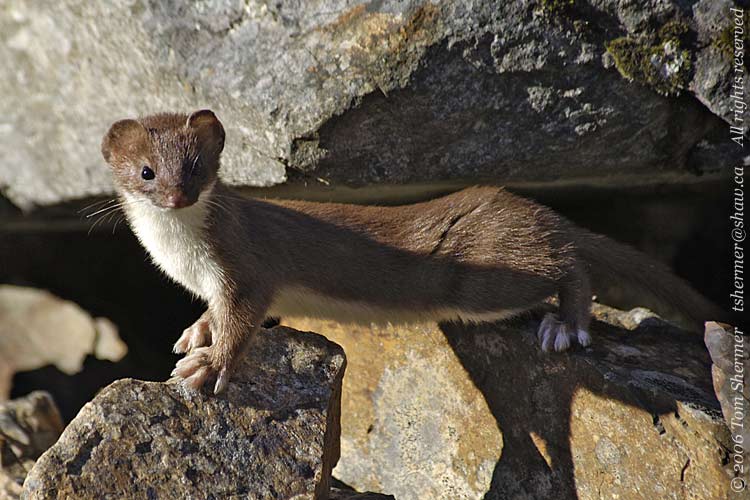 |
|
Herman was an energetic
soul, and he clambered around the rocks near me for ten minutes
or so. Unfortunately most of that time he spent a little east
of me, which put the sun behind him. On shots I took during that
time, his body and face are mostly in deep shadow and don't show
good detail.
Ermines are carnivores,
and they prey on small mammals, including Pikas. Supposedly, they're
fairly successful catching Pikas, too...the Pika's only real defense
mechanism is to retreat through the rocks to its burrow, but Ermines
are small and agile enough to follow where they go. I had read
about this predation when I was researching Pikas for my trip.
So, although I wasn't
expecting to see an Ermine, I had a good idea that that's what
Herman was when I saw him: it was no coincidence that I found
him there in Pika country.
Also not a coincidence
was the fact that all the chipmunks and pikas seemed to have disappeared
when Herman came around. Due partly to their absence, I decided
that this would be a good time to get back to the car and head
down the road. My plan was to drive east to Manning Park and perhaps
Princeton for the afternoon, in search of other subjects. So I
said bye to Herman and hiked up the talus to my car.
I was pretty happy
at this point, as I'd already found two mammals I'd never seen
before on this trip (Pikas and Ermines) and gotten what I knew
would be good photos of them both.
I did execute my plan
for the afternoon, but the results of that will have to wait for
my next entry.
Herman's new penpal,
Tom
|
|
|